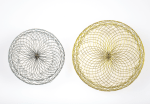The retrograde technique has significantly improved the success of percutaneous treatment of chronic total occlusions (CTO). After crossing a collateral channel, creating a connection between the anterograde and retrograde systems is key. The most common technique for this is reverse controlled antegrade and retrograde subintimal tracking (reverse CART). This technique involves inflating a balloon over...
Microvascular Resistant Reserve: Impact on STEMI Patients
Coronary Microvascular Dysfunction (CMD) is being increasingly considered a common consequence of STEMI. Its presence partly explains the persistence of angina symptoms in over 50% of patients after PCI, despite successful epicardial artery reperfusion. Also, CMD has been independently associated with worse left ventricular ejection fraction recovery, which leads to worse prognosis, including recurrent events,...
REPLICA-EPICA 18 Registry: Using IVL in Calcified Coronary Lesions
The presence of calcification in the coronary arteries (CAC) remains the main challenge in the percutaneous treatment of these lesions. Various studies have demonstrated the association of CAC with unfavorable long-term outcomes. Intravascular lithotripsy (IVL) has emerged as an effective tool for fracturing calcified plaques. Studies evaluating this strategy have shown high device success rates,...
EuroPCR 2024 | NOTION-2: TAVI vs SAVR, Randomized Study on Low-Risk Young Patients with Severe Tricuspid Disease or Bicuspid Stenosis
Many of the studies comparing TAVR against SAVR in low risk patients included patients between 70-75 years, excluding those with tricuspid valves. This study included low surgical risk patients with severe aortic stenosis and symptoms, 75 years or younger. Participants were randomized 1:1 to receiving TAVR or SAVR, stratified according to sex, need for new...
EuroPCR 2024 | Influence and Effect of CAD Physiopathological Patterns in the Safety and Efficacy of PCI
Coronary revascularization aims at improving coronary flow. However, after successful percutaneous coronary intervention (PCI) a significant number of patients might experience suboptimal coronary physiology. It has been observed that low fractional flow reserve (FFR) after PCI is associated to poor prognosis. Also, improved FFR after procedure directly correlates with improved angina symptoms. Pullback pressure during...
EuroPCR 2024 | SOLVE-TAVI: Self Expanding or Balloon Expandable Valves?
This was a randomized study with 447 patients carried out to compare the 5-year evolution of TAVR using Evolut R and SAPIEN 3, as well as general anesthesia vs. conscious sedation. Randomization was in two stages: first valve selection and later the anesthesia technique, that is, conscious sedation vs general anesthesia. The populations were similar....
Aortic Stenosis Progression Evolution
Aortic stenosis is an increasingly common valvulopathy because people are living longer now. A present, the main treatment consists of surgical (SAVR) or transcatheter aortic valve replacement. (TAVR). One of the main challenges of this disease is its progression. The European guidelines recommend Doppler echocardiograms every 2 to 3 years for mild cases, mildly calcified,...
Catheter-Based Therapy for Pulmonary Embolism: Lower Mortality and Rehospitalization?
Venous thromboembolism represents one of the main causes of cardiovascular death. Pulmonary embolism (PE) can vary from asymptomatic to manifesting with shock and sudden death, with a wide clinical spectrum. Patient followup is crucial, seeing as survival PE patients usually experience residual symptoms at long term, such as dyspnea or functional capacity deterioration. For decades,...
Evolution of Leak in Left Atrial Appendage Closure
Atrial fibrillation is common in elderly people and is associated with a higher risk of ischemic stroke. Left atrial appendage occlusion (LAAO) is a valid strategy, especially in patients at high risk of bleeding. The presence of peridevice leak (PDL) has been linked to stroke, although some analyses, such as the PROTEC-AF Study, suggest that...
LpA: 30-Year Cardiovascular Followup in Primary Prevention Cohorts
For years, treating dyslipidemia mainly focused on reducing LDL cholesterol (LDL-C) with statins, which had shown benefits in reducing atherosclerotic cardiovascular disease (ASCVD). Lipoprotein(a) [Lp(a)] is a form of apoB-containing lipoprotein bound to a hydrophilic, highly glycosylated protein called apolipoprotein(a) [apo(a)]. Circulating levels of Lp(a) are genetically determined, and are hardly affected by eating habits...







